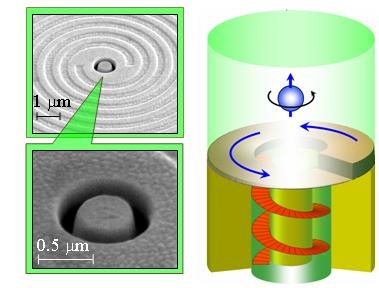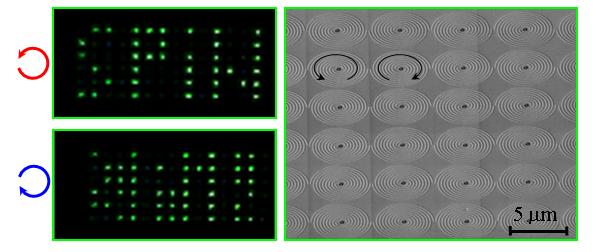The editor of the prestigious journal Nature Materials selected the work as a breakthrough in nanophotonics

The Technion researchers, Prof. Erez Hasman, Dr. Vladimir Kleiner, Yuri Gorodetsky, Nir Shtrit, and Iti Bretner, from the Laboratory for Micro and Nano-Optics in the Faculty of Mechanical Engineering and the Russell Berry Institute for Research in Nanotechnology, succeeded in "screwing" light and introducing it into a nanometer hole with a diameter of one thousandth of a hair. This was published in the scientific journal Nano Letters and defined by the editor of the prestigious scientific journal Nature Materials as a breakthrough with very promising results for application in the realization of optical components on the nanometer scale.
Also, the research work was chosen by the American Optics Association as one of the most important studies in nano-optics for 2009. The researchers hope that this will be used in computers in communication and displays and in the future it will be possible, thanks to this, to reduce the components down to the nano scale and significantly improve the performance of computers.
"Until 1998, it was known that light does not pass through such a tiny hole, which is much smaller than a wavelength," says Professor Erez Hasman. "In 1998, a groundbreaking paper was written by Professor Thomas Ebsen from the University of Strasbourg, who showed that under certain conditions, light can also pass through such a tiny hole. In the laboratory for micro and nano optics we created a small hole, in the shape of a 'pretzel', on a thin layer of gold. We implemented this using a focused ion beam. Around the hole we created 'spiral grooves', similar to screwing a screw. Through the hole we sent light, and gave it a spin, a kind of 'whirlpool'. When the direction of the swirl matched the screw we created in the hole - the light penetrated through. For a light in a spin that did not fit the screw, the light did not go through." This is the first time that it has been proven that it is possible to control the light passing through a nanometer hole with the help of its spin, and this will allow in the future to make logic components in light at the nano level, when the logic component is controlled by the spin of the light.

At the end of 2008, Professor Hasman and his team succeeded in developing a new way to control light on a nanometer scale by means of 'spinning' (as you "spin" a tennis or ping pong ball). "The creation of a lateral force on a rotating cylindrical or spherical solid immersed in a liquid (or gas) when there is a relative movement between the rotating body and the liquid is called the Magnus effect," Professor Hasman explains.
"The German physicist Heinrich Magnus first described the effect in 1853. In many ball games, the Magnus effect is responsible for the trajectory of a spinning ball (for example, a soccer, tennis or ping pong player who 'spins' the ball). The Magnus effect also affects the trajectory of rotating missiles, and affects the flight of certain aircraft. Electromagnetic waves, which also behave as massless particles called photons, have an internal property - 'spin' of the photons. The spin, which is the internal angular momentum of the photons, depends on the direction of the circular polarization of the light.
The Technion researchers reported in their article from 2008 on a unified theory on the subject and for the first time on a direct experimental observation of a spin-dependent deviation - the Magnus effect in photons. The Magnus effect for light (also called the spin Hall effect), causes light to deviate due to the interaction between the spin of the photons and the shape of its trajectory. The possible implications of their work are very broad. "The application of this effect with photonic and nano-optical means may lead to the development of a new field of research - spin optics", says Prof. Hasman. "We hope that we will be able to control light on a nanometer scale, in ways that have not been possible until now."
The current breakthrough is a direct continuation of that research.

8 תגובות
Will this bring us closer to real holograms?
http://www.youtube.com/watch?v=DfPeprQ7oGc
Adi, I'm really not well versed in physics, and my knowledge is based on the wonderful book of thoughts edited by Zvi Yanai from over 20 years ago (hint at my advanced age) In that experiment, they placed a photon shooter in front of a small slit, and it turned out that on the opposite screen, even though photons were shot individually, a phenomenon of interference was created that indicates Gal's software . And here, according to the current article, it is possible to create such a small slit, which captures the photon of light and then release it (and I think its polarization can also be controlled.) I wonder if shooting photons through such a small slit will still cause a phenomenon of interference on the screen opposite? Einstein's later experiments, in which the movement of one particle with a certain polarization will cause a polarization to be detected in the opposite particle, can also be checked again, after all it is finally possible to capture the same particle and look at it.
DP:
In addition to what was said above, the simplest experiment (that comes to my mind) that contradicts what you said "the particle will behave as a classical particle if your experiment is on a size scale that is larger than it" is the Stern-Gerlach experiment. Both the magnets involved and the distances (up to the screen, and on the screen between the spots) are of a macroscopic size and yet the spin feature is manifested - a completely quantum phenomenon.
Uri S:
What is wrong with the original experiment that can be improved with the technology described in the article? What problem did she come to overcome?
Matter is not energy, matter is mass, it is different from energy, but you can turn mass into energy and vice versa.
There is no particle-wave paradox.
The material is waves of energy in different densities of the energy (of course there are many other things that allow you to feel the material).
Simply, if you are on a ZOOM OUT scale, you will see a particle, and the particle will behave as a classical particle if your experiment is on a larger size scale. If you shoot to a smaller scale the particle will behave as a wave - assuming it is an elementary particle.
I can definitely see a future in the computing world - spin in one direction = 1 (light passes), spin in the other direction = 0 (light does not pass). We have a nanoscale binary system here.
I'm not really into physics but I'd love to try to understand. Is it possible to reproduce the photoelectric experiment under the current nano conditions, and test the particle/wave paradox under new conditions?